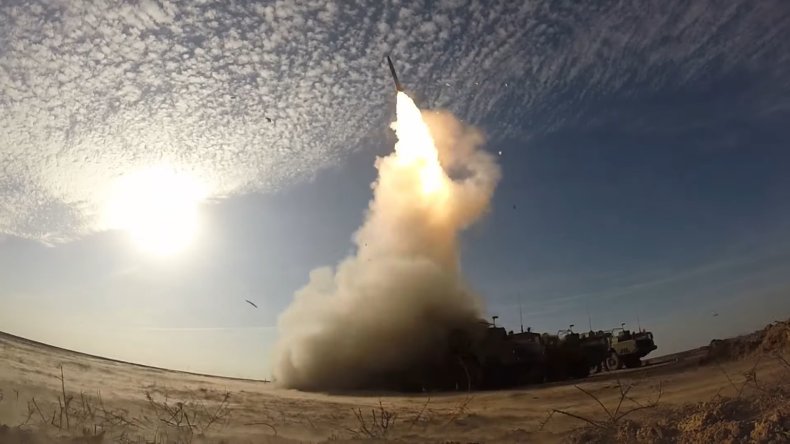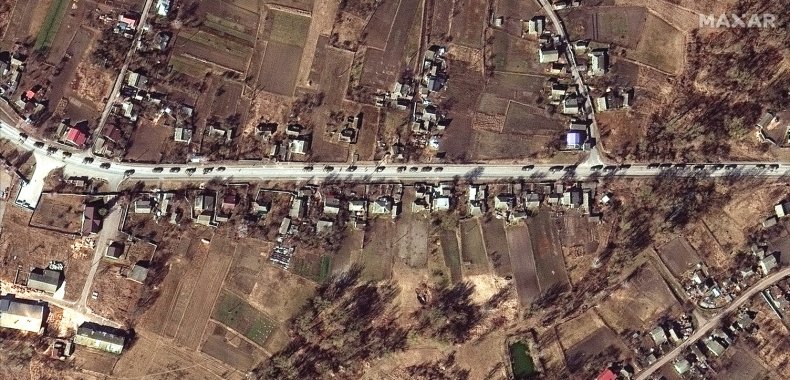Russia Now Controls Sky Over Ukraine, Aviators Say: 'If They Fly, They Die'
Russia has established effective dominance over the skies of Ukraine, leaving little room for Kyiv's remaining warplanes to operate, even as Moscow sends in an apparently stalled, vulnerable convoy of reinforcements by land, aviators with military experience told Newsweek.
"They're essentially grounded. If they fly, they die," Ward Carroll, a retired U.S. Navy commander who flew combat missions in the F-14, told Newsweek of Ukraine's embattled air force.
Given Russia's overwhelming airpower, an asset that Moscow appears to be increasingly leveraging as the war enters its second week, Carroll, an author who also hosts a YouTube channel discussing military affairs, said any sorties flown by the Ukrainian jets at this stage of the conflict "would be a last-ditch mission."
"That's why," he said, the idea of simply just sending in more aircraft such as MiG-29s "is moot at this point." He said that "Ukrainians can fly for short sorties, quick strikes, and then back on deck and hide the jets."
The situation is such that Russia asserts effective control over an altitude of 10,000 feet, and Carroll notes that "whoever has dominion above 10K has air superiority." And this "doesn't mean Ukrainians own below that" either, he said.
Ukraine still retains some of its anti-aircraft capabilities, including in the form of shoulder-fired Stinger missiles provided by the United States. But the threat posed by these platforms is largely limited to "assault helicopters and transport aircraft trying to land," Carroll said.
"Once you own the skies above 10K, you can manage the surface-to-air missile threat as it arises," he added.
The situation severely restricts Ukraine's capability to hit even potentially tantalizing targets such as a sprawling Russian convoy stretching some 40 miles northwest of Kyiv.
As long as Ukraine fails to attain "air superiority or parity," one combat military aviator with theater planning experience told Newsweek, "the Russian ground forces can achieve freedom of movement with impunity...i.e. a 40-mile long invasion convoy on an open road."

Part of Russia's advantage lies in its own state-of-the-art defenses, including the S-400 surface-to-air missile system, known to NATO as SA-21 and capable of taking out targets at ranges of 400 kilometers, or roughly 250 miles.
The combat military aviator pointed out that these systems, present not only in Russia itself but in allied Belarus and the Crimean Peninsula annexed from Ukraine after an international disputed referendum, have been "pushed to the border," putting much of Ukraine's airspace within range.
"The S-400 and SA-21 surface-to-air missile threat range is practically all of Ukraine from the border," said the combat military aviator, who asked not to be named.
And with Russia having targeted not only airfield and anti-air equipment but also radar sites in the opening salvo last week and ensuing strikes on Ukraine, Kyiv's visibility is likely limited as well.
As such, the combat military aviator corroborated Carroll's account in saying that Ukrainian air missions were likely "very short: take-off, strike target, land before Russians can react."
"If the Ukrainians were able to achieve air parity for even a few minutes through a cyber or other non-conventional attack on the Russian air defense systems, then they could annihilate that column," the combat military aviator said.
Reports have emerged of limited Ukrainian airstrikes on the convoy. In an interview Wednesday with Military Times, Ukrainian Brigadier General Kyrylo Budanov said that Ukrainian Su-24 and Su-25 fighter jets were "striking the enemy's columns."
The information could not be independently verified, however, and the Pentagon also declined to comment in depth on the matter.
"We don't have any reason to doubt Ukrainian claims that they have attacked this convoy in places and helped slow it down. No reason to doubt that," a senior Pentagon official told reporters Thursday. "How they've done that, I think they can speak to and they should speak to that."
As to whether drones, such as TB2 Bayraktars provided to Ukraine by NATO member Turkey, may have been involved, the senior Pentagon official said "we're not going to want to put a whole lot of information out there in the information space that makes it harder for the Ukrainians to defend their country."
What appears certain, however, is that the convoy has not moved significantly in days. Speculation, partially backed by Pentagon officials, has pointed to a number of potential factors, including logistical setbacks and even muddy roads.
As for the skies above it, the senior Pentagon official continued to describe Ukraine's airspace as "contested."
"We assess that Ukrainian air and missile defense systems remain intact, and they remain effective," the senior Pentagon official said. "They continue to be able to fly their airplanes and to employ air defense assets. And as of this morning, we've now counted more than 480 Russian missile launches, again, of all sizes and strengths."
And the senior Pentagon official attributed this to a number of factors, including a "creative" application of Ukrainian assets as well as "some indications of Russian misapplication of their resources and, in some cases, risk adversity."
Beyond this, Pentagon spokesperson Marine Lieutenant Colonel Anton Semelroth told Newsweek he had "nothing to offer regarding intelligence assessments."

And yet Russia's convoy, which threatens to bring substantial personnel and firepower to back Moscow's bid to take Kyiv, remains largely untouched.
Part of this may be rooted in Russia's own electronic warfare capabilities, a field in which Moscow has invested heavily but remains largely unseen on the battlefield. In the event that Russia has unleashed its electric arsenal, then even if Ukraine had more advanced surviving defense systems such as the S-400 predecessor, the S-300, they may be of little use.
"If Russia can suppress those systems by keeping aircraft on the ground and electronic warfare suppression of missile radar and tracking, then they can still own air superiority," a U.S. military officer who flew combat missions in tactical aircraft told Newsweek.
The military officer gave two potential reasons as to why Russia's reinforcements lie out in the open mostly unscathed. One is that Russian forces "enjoy air superiority (or think they do)" and the other is that "Ukraine doesn't have enough systems to target and kill the convoys."
One way or another, the military officer said Russian forces "don't feel threatened."
And until this changes, the military officer said that Moscow's convoy may be a "super juicy target looking from the sky," but Ukraine's military largely "can't do anything about it."